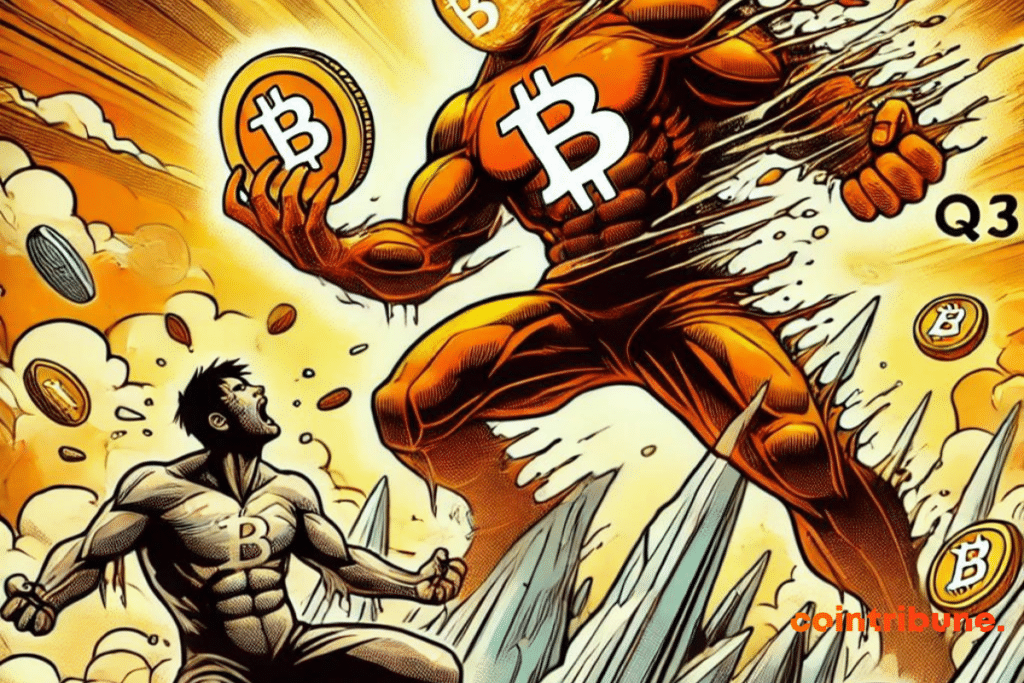📈 Market Overview:
— CoinMarketCap (@CoinMarketCap) October 3, 2024
• Global crypto market cap: $2.24T (-0.13% in Q3)
• 24hr trade volume: $89bn (+12.6% in Q3)
• BTC dominance: 56.8% (highest since April 2021)
• Stablecoin market cap: $160B ATH (2.5x April 2021 levels)
Bull Market Progress: 40.66% (100 days ahead of… pic.twitter.com/tT0EO727Hn
A
A
Bitcoin Dominates in T3 While DeFi Struggles!
Sat 05 Oct 2024 ▪
4
min read ▪ by
▪
Event
The third quarter of 2024 was a real whirlwind for the crypto market. While some assets shone, others are struggling to keep up. Bitcoin, unassailable, has strengthened its dominance, reaching levels it had not seen for two years. Conversely, decentralized finance (DeFi) seems to be entering a critical phase, struggling to regain its former dynamism. But what is really behind these opposing trends? Let’s dive into the analysis of this tumultuous Q3 together.

Bitcoin: an undeniable dominance
Bitcoin (BTC), often described as digital gold, has once again confirmed its status as the king of cryptos.
In Q3, its dominance reached 56.8%, an impressive figure that had not been observed since April 2021.
This resurgence of Bitcoin, despite a relatively stable overall market (-0.13% in market capitalization), marks a massive resurgence of interest in this asset. Why this trend? Several factors explain this rise in power.
First, the solidity of bitcoin in times of uncertainty. As global markets falter in the face of unpredictable monetary policies, Bitcoin offers a safe alternative for many investors.
Its status as a store of value, already well established, has been further strengthened in recent months, and rising transaction volumes (+12.6% in Q3) confirm this dynamic.
Then, the rise of stablecoins, with capitalization reaching a historic high of 160 billion dollars, has indirectly favored Bitcoin.
Stablecoins, although stable by definition, do not allow the same speculative gains as Bitcoin. The latter thus remains the preferred destination for investors seeking more aggressive exposure to the crypto market.
Finally, the impact of regulations in several countries has played in favor of bitcoin. While other sectors, such as DeFi, are often the target of new restrictive laws, Bitcoin, as the market pioneer, retains a favorable position in institutional portfolios.
This relatively favorable regulatory framework has allowed it to maintain its leadership despite the diversification of the market.
DeFi: the giant in decline
While Bitcoin shines, DeFi is going through a dark period. With a 21.4% decline in total value locked (TVL) since its annual peak, the decentralized finance sector seems in trouble.
This fall is not trivial and raises several questions: is DeFi experiencing a prolonged winter or is it simply a pause before a new momentum?
The lending sector, once the pillar of DeFi, has also shown signs of weakness, recording a 9% drop in Q3. Even Lido, a leader in the staking field, has seen its market share decrease from 31.9% to 28.4%.
This contraction is partly explained by the rise of new more speculative sectors, such as artificial intelligence (AI) and meme tokens, which have attracted capital formerly destined for DeFi.
Moreover, DeFi suffers from its lack of regulatory clarity. Unlike Bitcoin or even stablecoins, often better perceived by regulators, DeFi is perceived as a risky sector. This legal uncertainty chills institutional investors, thus hindering the massive adoption that some had hoped for.
However, not all is bleak for DeFi. Some innovative projects continue to attract attention, and initiatives in the cross-chain and interoperability domain could breathe new life into the ecosystem. Moreover, with sectors like NFTs and GameFi showing signs of recovery, it is possible that DeFi will regain vigor, but in a renewed form. Meanwhile, whales anticipate a massive rebound with 50,000 BTC acquired.
Maximize your Cointribune experience with our "Read to Earn" program! For every article you read, earn points and access exclusive rewards. Sign up now and start earning benefits.
A
A

Fascinated by Bitcoin since 2017, Evariste has continuously researched the subject. While his initial interest was in trading, he now actively seeks to understand all advances centered on cryptocurrencies. As an editor, he strives to consistently deliver high-quality work that reflects the state of the sector as a whole.
DISCLAIMER
The views, thoughts, and opinions expressed in this article belong solely to the author, and should not be taken as investment advice. Do your own research before taking any investment decisions.